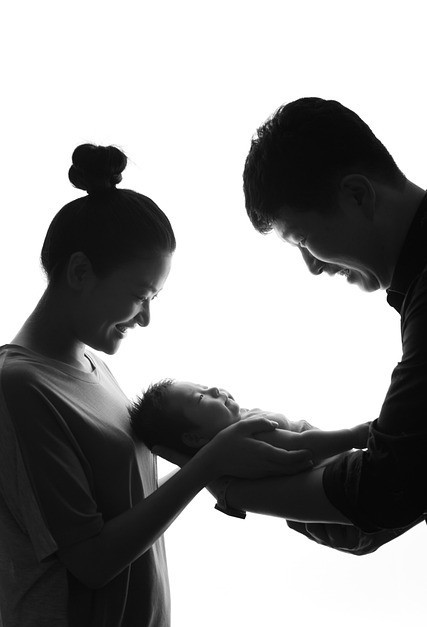
Swaddling a baby is an ancient practice of wrapping an infant in a cloth or a thin blanket so that the baby’s movement is restricted, to help them feel secured. A thin blanket wrapped snuggly around your baby’s body can resemble the womb and help soothe your newborn. Swaddling provides your baby a sense of security, protects your baby against their natural startle reflex, which means a better sleep for your baby. The startle reflex or “Moro reflex” is a normal reflex when babies throw back their head, extending out their arms and legs, crying, then pulling their arms and legs in. Absence of starte reflex or Moro reflex is abnormal for a baby, and would indicate something is wrong. Loud noises, intense light, and sudden movements can trigger a baby’s Moro reflex. They can even trigger it in themselves when they move suddenly. It normally goes away after 3 or 4 months.
Babies who aren’t swaddled can be more prone to waking themselves up after a startle reflex, which can happen when you lay your little one down in their crib.
Is swaddling safe?
According to the American Academy of Pediatrics (AAP), swaddling can be an effective technique to help calm infants and promote sleep when done correctly. It is also linked with helping to reduce the risk of SIDS in infants that are not yet able to roll over on their own.
When swaddling a baby, you still make sure that you are following safe sleep guidelines such as laying your baby to sleep on their back in their own space (like a bassinet or a crib), using a firm mattress with no loose blankets or sheet around.
Swaddling Guidelines and Safety Considerations
Check that the swaddling isn’t too tight or constricting especially around the hips and legs. Your baby’s legs should be free to fall into their natural frog-like position. Wrapping your baby too tightly in a swaddle can lead to hip dysplasia or dislocation.
Safety is of utmost importance when swaddling a baby to ensure their well-being and reduce the risk of accidents or harm. Here are some safety considerations to keep in mind:
- Follow the ABCs: Always place the baby on their back to sleep. This reduces the risk of Sudden Infant Death Syndrome (SIDS).
- Use lightweight, breathable materials: Choose swaddling blankets made of thin, breathable fabric to prevent overheating and ensure adequate airflow.
- Avoid covering the face: Make sure the swaddle does not cover the baby’s face. The baby should be able to breathe easily and not be at risk of suffocation.
- Keep the hips loose: Allow enough room for the baby’s hips to move freely to prevent hip dysplasia. The baby’s legs should be able to bend up and out at the hips.
- Monitor temperature: Ensure the baby doesn’t get too hot while swaddled. Overheating can increase the risk of SIDS. Keep the room at a comfortable temperature, and avoid using additional blankets over the swaddle.
- Don’t swaddle too tightly: Swaddle the baby snugly, but not too tight. The swaddle should allow some movement for the baby’s legs and hips.
- Stop swaddling when the baby shows signs of rolling: Once the baby starts to show signs of rolling over, it’s time to stop swaddling. Rolling over while swaddled can be dangerous.
- Choose the right size: Use swaddling blankets that are appropriate for the baby’s size. Oversized blankets can lead to improper swaddling and potential hazards.
- Check for wear and tear: Regularly inspect the swaddling blankets for signs of wear and tear. Discard any blankets that have holes or loose threads.
- Educate caregivers: If others will be swaddling the baby, ensure they understand the proper swaddling techniques and safety considerations.
- Avoid loose bedding in the crib: Once the baby can roll over, remove any loose blankets or toys from the crib to prevent suffocation hazards.
- Trust your instincts: If the baby seems uncomfortable, distressed, or is consistently breaking out of the swaddle, consider trying a different swaddling technique or transitioning to an alternative method.
Remember that every baby is different, and what works for one may not work for another. It’s essential to stay attentive to your baby’s cues and adjust the swaddling technique accordingly. If you have any concerns or questions about swaddling, don’t hesitate to consult with your pediatrician or a qualified healthcare professional.
Step-by-Step Instructions for the Common Swaddling Techniques (the diamond swaddle, the square swaddle and the hands-to-heart swaddle)
- Diamond Swaddle:
This technique involves folding the swaddling blanket into a diamond shape to wrap the baby snugly.Step 1: Lay the swaddling blanket flat on a clean surface in the shape of a diamond, with one corner pointing upwards.Step 2: Place the baby on their back in the center of the blanket, with their shoulders just below the top edge of the diamond.Step 3: Gently straighten the baby’s left arm and wrap the left corner of the blanket over their body and tuck it under their right side.Step 4: Fold the bottom corner of the blanket up over the baby’s feet, tucking it securely behind their shoulders.Step 5: Straighten the baby’s right arm and bring the right corner of the blanket across their body, tucking it under their left side.Step 6: To complete the swaddle, fold the top corner of the blanket down and tuck it under the baby’s back, ensuring it’s snug but not too tight around the hips and legs. - Square Swaddle:
This method uses a square-shaped swaddling blanket, and it’s an easier technique for some parents.Step 1: Lay the square swaddling blanket flat on a clean surface in a diamond shape, with one corner pointing upwards.Step 2: Fold the top corner down slightly to create a straight edge across the top of the diamond.Step 3: Place the baby on their back in the center of the blanket, with their shoulders just below the top straight edge.Step 4: Take the left corner of the blanket and wrap it snugly across the baby’s body and tuck it under their right side.Step 5: Fold the bottom corner of the blanket up over the baby’s feet, tucking it behind their shoulders.Step 6: Take the right corner of the blanket and bring it across the baby’s body, tucking it under their left side.Step 7: Fold any excess fabric from the top of the blanket down, ensuring the swaddle is snug but not too tight around the hips and legs. - Hands-to-Heart Swaddle:
This technique allows the baby to have their hands near their face, providing comfort and self-soothing. - Step 1: Lay the swaddling blanket flat on a clean surface in a diamond shape, with one corner pointing upwards.
- Step 2: Place the baby on their back in the center of the blanket, with their shoulders just below the top corner of the diamond.Step 3: Gently straighten the baby’s left arm and wrap the left corner of the blanket over their body, leaving their left arm out and tucking the blanket under their right side.Step 4: Fold the bottom corner of the blanket up over the baby’s feet, tucking it securely behind their shoulders.Step 5: Straighten the baby’s right arm and bring the right corner of the blanket across their body, leaving their right arm out and tucking the blanket under their left side.Step 6: To complete the swaddle, fold the top corner of the blanket down and tuck it under the baby’s back, ensuring it’s snug but not too tight around the hips and legs.
Remember, it’s essential to keep the swaddle snug but not overly tight, and always position the baby on their back to sleep. Additionally, as the baby grows and shows signs of rolling, it’s time to transition away from swaddling for safety reasons.
Encouragement for new parents to find what works best for their baby
Being a new parent is an awe-inspiring and transformative experience. From the moment your baby arrives, you are inundated with new responsibilities and emotions. Amidst the joys and challenges, it’s essential to remember that you have the power to find what works best for your baby. Here’s an expanded encouragement to help you on this incredible journey:
- Embrace the Learning Process: Parenthood is a journey of discovery. You are learning alongside your baby, understanding their cues, preferences, and needs. Every day brings new insights and opportunities to grow as a parent. Embrace the learning process with an open mind and heart.
- Trust Your Instincts: You have an innate ability to understand and connect with your baby. Trust your instincts – that parental intuition is real and powerful. You know your baby best, and your instincts will guide you through the challenges and decision-making.
- Be Patient with Yourself: Parenting can be overwhelming, and it’s okay to feel uncertain at times. Be patient with yourself as you adjust to this new role. Remember that no parent is perfect, and it’s okay to make mistakes. What matters most is the love and care you provide for your baby.
- Customize Your Approach: There’s no one-size-fits-all approach to parenting. Each baby is unique, and what works for one may not work for another. Pay attention to your baby’s cues and temperament, and tailor your care accordingly. You are crafting a personalized parenting style that suits your baby’s individuality.
- Seek Support and Share Experiences: Don’t hesitate to seek support from friends, family, and parenting communities. Sharing experiences and learning from others can be incredibly helpful. Surround yourself with a supportive network of people who uplift and encourage you on your journey.
- Stay Informed, but Don’t Overwhelm Yourself: With the plethora of information available online and in books, it’s easy to feel overwhelmed. Stay informed, but be selective about the sources you follow. Remember that your baby is unique, and not everything you read will apply to your specific situation.
- Take Time for Self-Care: Parenting can be all-consuming, but remember to take time for self-care. Your well-being matters too. Prioritize rest, nourishing meals, and activities that rejuvenate your mind and spirit. A refreshed and happy parent can better care for a happy and content baby.
- Celebrate the Milestones, Big and Small: Celebrate each milestone your baby achieves, whether it’s a first smile, a successful feeding, or a peaceful night of sleep. These moments are precious, and they remind you of the incredible progress your baby is making.
- Be Flexible and Adapt: Babies are constantly changing, and what works one day may not work the next. Be flexible and adaptable in your approach. Embrace change with an open mind, and don’t be afraid to adjust your routines as your baby grows.
- Cherish the Journey: Parenthood is a fleeting and beautiful journey. Cherish every moment, even the challenging ones, as they are all part of the incredible bond you are building with your baby.
You are embarking on one of life’s most extraordinary adventures – the gift of nurturing and raising a child. Embrace the magic, the mess, the laughter, and the tears. You’ve got this! The love you pour into your baby’s life will shape their future, and your dedication will be remembered forever.

Final words of advice and reassurance for the journey of parenthood
Parenthood is a beautiful and transformative journey filled with moments of joy, love, and growth. As you embark on this incredible adventure, here are some final words of advice and reassurance to guide you along the way:
- Trust Your Instincts: You are your baby’s first and best teacher. Trust your instincts and intuition as a parent. You will learn to understand your baby’s needs and respond with love and care.
- Embrace Imperfection: Parenthood is not about being perfect; it’s about being present and doing your best. Don’t be too hard on yourself. Mistakes and challenges are natural, and they provide opportunities for growth and learning.
- Seek Support: Parenting can be overwhelming at times, and it’s okay to ask for help. Reach out to family, friends, or support groups for advice, encouragement, and a listening ear.
- Be Kind to Yourself: Remember to take care of yourself physically and emotionally. Self-care is crucial for maintaining your well-being and being the best parent you can be.
- Cherish Every Moment: Time passes quickly, and your baby will grow faster than you can imagine. Cherish the precious moments, from the sweet snuggles to the little milestones. Create lasting memories to cherish in the years to come.
- Embrace Flexibility: Parenthood requires flexibility and adaptability. Be open to adjusting your plans and expectations as your baby’s needs change.
- Foster a Loving Environment: Provide a nurturing and loving environment for your child to thrive. Your love and attention are the foundations for their emotional development.
- Stay Patient: Parenthood can be challenging, but staying patient and calm in difficult moments can make all the difference. Take deep breaths, step back if needed, and remember that this phase will pass.
- Celebrate Progress: Celebrate not only your baby’s milestones but also your growth as a parent. Each step forward is an accomplishment for both of you.
- Embrace the Journey: Parenthood is an incredible journey with ups and downs. Embrace the journey with all its surprises and joys. You’ll witness the wonder of life through your child’s eyes and discover a love like no other.
Remember that every parent’s experience is unique, and there is no one-size-fits-all approach to raising a child. Be patient with yourself, enjoy the little moments, and create a loving and supportive environment for your child. You’ve got this, and you are already a fantastic parent simply by caring and being there for your little one. Congratulations, and may your journey through parenthood be filled with abundant love and happiness!



